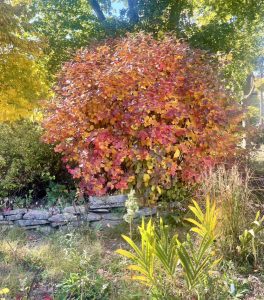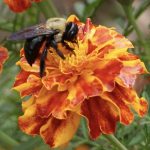In the meantime, we’ve had a remarkable beginning of November, haven’t we? The nice weather is great for admiring the glorious fall foliage (see my lovely fothergilla!) and for doing things in the garden before winter sets in.

This season of changes brings revelations and opportunities. For instance, when their leaves change color, scores of tree seedlings that were hiding in the greenery show themselves, giving me a chance to remove them before the leaves drop and they become invisible little sticks. I enjoy pulling them out, tearing off the leaves, and scattering the leaves and bare twigs onto the ground to compost in place—chop and drop, as they say. The Hydrangea arborescens are losing their leaves, which shows off their dried flower heads, and also lets me see the stray bits of vinca, ivy, and creeping euonymus that are trying to sprout at their feet. Ha! Gotcha.
Rambunctious spreaders like white snakeroot and late boneset bear masses of flowers that go spectacularly to seed, so I remove the seed-laden branches to scatter elsewhere (leaving stalks for the bees, now doing their final foraging but soon to be looking for nesting sites). The resulting visibility shows me where the birds have been spreading ivy and porcelainberry: fresh little sprouts of both are now visible, fortunately still small enough to be pulled right out.
Where I can, I’m trying to establish a “base layer” of low-growing, noninvasive ground covers, rather than mulch. (In my garden, this approach seems to work best in mixed sun and shade.) As leaves die down, it’s a good time to check those ground cover areas for weedy interlopers. I can see places where I need to help out the good guys by adding some wood chips or leaves. In other areas, particularly in full sun, I need to add a thick layer of wood chips if I’m going to foil the winter weeds—I’ve already seen some well-grown hairy bittercress in our “lawn,” and sure enough, when I look in the beds, there are the seedlings starting to sprout. This is when the scuffle hoe comes in handy.
In my wild and woolly “meadow” areas, it’s time to make decisions about what to leave standing for wildlife and winter interest, and what to remove because it’s just in the wrong place.  Any invasives are removed, obviously, but there are also the aggressive natives that need to be reined in, not to mention all the saplings trying to take over. Time to start stacking brush in strategic places! Thus can I satisfy my (weak) urge toward tidiness, while still helping out the bees and other little critters sharing my garden.
Any invasives are removed, obviously, but there are also the aggressive natives that need to be reined in, not to mention all the saplings trying to take over. Time to start stacking brush in strategic places! Thus can I satisfy my (weak) urge toward tidiness, while still helping out the bees and other little critters sharing my garden.